#1863 fashion
Explore tagged Tumblr posts
Text

submitted by @dewdropsongrasss 💛💜
#historical fashion poll submission#historical fashion polls#fashion poll#historical dress#historical fashion#dress history#fashion history#fashion plate#19th century#19th century fashion#19th century dress#mid 19th century#circa 1860#1860s fashion#1860s dress#1860s#1863#skirt
209 notes
·
View notes
Text
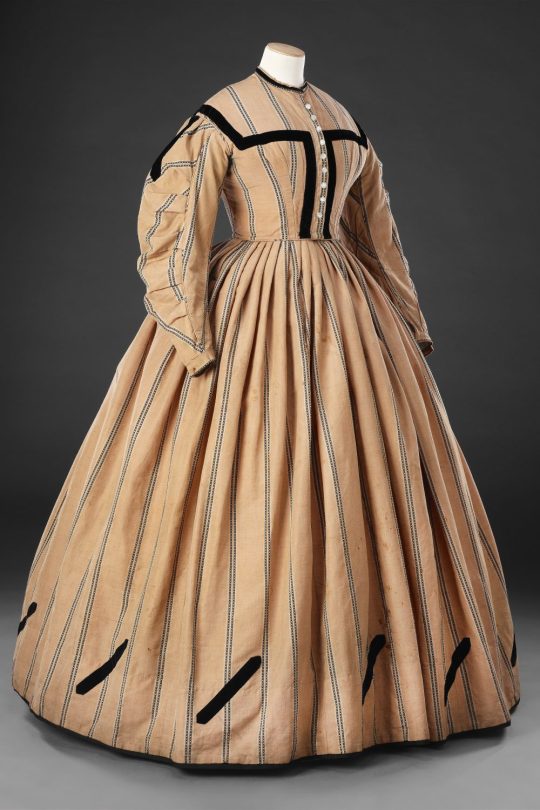
Day Dress
Early 1860s
By the early 1860s the width of the skirt, supported by the crinoline frame, had reached its zenith. Such a surface area provided the perfect canvas for bold, decorative effects, and contemporary photographs, fashion plates and surviving garments show large designs of strongly-contrasting applied velvet or braid encompassing the skirt above the hem, echoed on a smaller-scale on the bodice. The maker of this unpretentious one-piece day dress has interpreted this fashion in a simple, but effective, manner. Black velvet ribbon has been stitched to the bodice to suggest a yoke, and diagonal strips of ribbon with pointed ends have been applied to the base of the skirt at intervals, and to the tops of the sleeves. The dress has been made by hand from a worsted wool fabric, possibly incorporating linen, which has a slightly harsh but practical character; it is woven with bands of simple black pattern which have been matched symmetrically on both bodice and skirt. In common with many one-piece dresses of this date a small watch pocket has been inset at the left front waist seam. The dress’s one concession to complexity is the construction of the sleeves which are pleated into a piped curved seam running down the front of each sleeve.
The John Bright Collection
#day dress#fashion history#historical fashion#1860s#crinoline era#19th century#1860#1861#1862#1863#wool#velvet#brown#john bright collection
250 notes
·
View notes
Text


Reproduction of a dress belonging to art collector Joséphine Bowes (1863)
theliteraryshed / redrazors
#joséphine bowes#fashion history#historical fashion#victorian fashion#history of fashion#history of dress#victorian dress#victorian era#victoriana#victorian#19th century#19th century fashion#mid 19th century#1860s#1860s fashion#1863
178 notes
·
View notes
Text
Valentine Cameron Prinsep, Il Barbagianni, 1863

102 notes
·
View notes
Text

La Mode illustrée, no. 28, 13 juillet 1863, Paris. Alphabet en ruban de chez M. Morel, dessinateur, rue de Londres, 32. Ville de Paris / Bibliothèque Forney
#La Mode illustrée#19th century#1860s#1863#on this day#July 13#periodical#fashion#alphabet#pattern#Forney#Modèles de chez#M. Morel
50 notes
·
View notes
Text
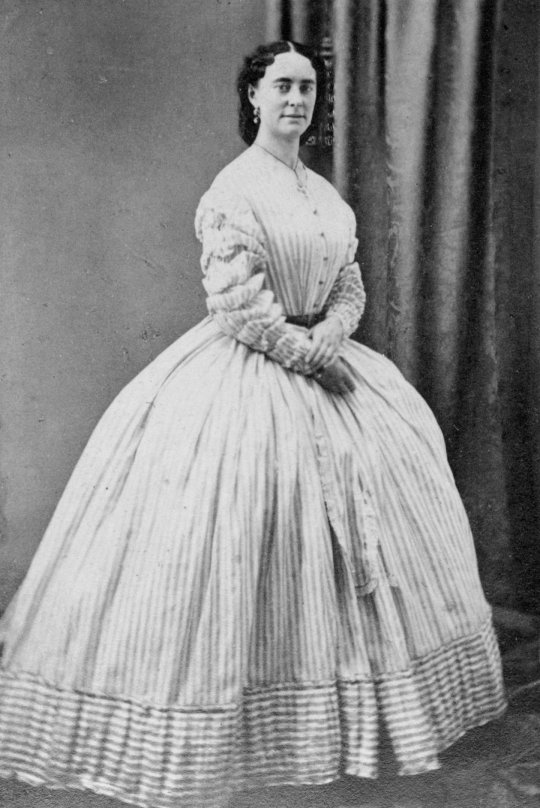
Zelma Hedin (1827 - 1874), 1863
#1863#1860s#history#historical#fashion#fashion history#historical fashion#1860s fashion#1860s dress#victorian#victorian era#victorian fashion#victorian aesthetic#history tag#1800s photography#1800s dress#1800s fashion#19th century fashion#19th century#19th century dress#antique#antiquebee
33 notes
·
View notes
Text





• Gold brown dress.
Date: 1863-1868
Medium: Silk
#fashion history#history of fashion#dress#fashion#19th century fashion#19th century#19th century dress#gold brown dress#silk#1863#1868
332 notes
·
View notes
Text
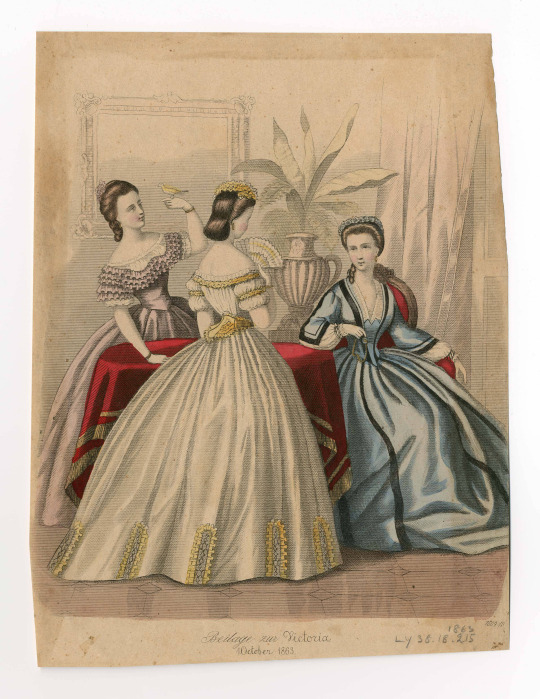
Formal gowns, 1st October 1863.
#fashion plates#historical fashion#clothing#women's fashion#colour illustration#19th century#century: 1800s#dress#era: victorian#day: 1st#day: 1er#date: 1 october 1863#month: october#year: 1863#decade: 1860s#publication: beilage zur victoria#era: german confederation#era: post-revolutionary#formal#gown#ball gown#evening gown#dinner dress#white#yellow#blue#pink
3 notes
·
View notes
Text

A rare photo of The Prince and Princess of Wales, c. 1863.
20 notes
·
View notes
Text

THE STRIKING ARTISTRY OF THE KABUKI ACTOR'S PORTRAIT -- THE WIZARDRY OF THE TRADITIONAL WOODBLOCK PRINT.
PIC INFO: Spotlight on a woodblock print by illustrator Utagawa Kunisada I (Toyokuni III) of the Kabuki theater actor Ichikawa Ebizō V., playing the role of Usui Sadamitsu, the piece was reportedly published c. September 1863.
EXTRA INFO: "Featuring 200 prints by 89 artists, Taschen’s book "Japanese Woodblock Prints (1680-1983)" is a journey through two centuries of the art form. Ranging from depictions of everyday life to kabuki and erotica, the XXL edition is a 622-page art history lesson and a high-resolution visual compendium rolled into one."
-- TASCHEN BOOKS (luxury artbooks publisher)
Source: www.itsnicethat.com/articles/japanese-woodblock-prints-taschen-publication-021219 & Wikimedia.
#Japanese Woodblock Print#Japanese Art#Utagawa Kunisada#Kunisada Utagawa#1863#1860s#Kabuki Theatre#Japanese Woodblock#Japanese Culture#Utagawa Kunisada Artist#Japanese Woodblock Prints#Ichikawa Ebizō V#Usui Sadamitsu#Kunisada Utagawa Artist#Kabuki Theater Makeup#Kabuki#Kabuki Art#Kabuki Theater Art Prints#Kabuki Art Prints#Taschen#Taschen Books#Historical Fashion#Kunisada Utagawa Art#Kabuki Theater Actor#Japanese#Kabuki Actor#Kabuki Culture#Japan#Woodblock#Woodblock Art
4 notes
·
View notes
Text

submitted by @dewdropsongrasss 🖤🩶🤍
#historical fashion poll submission#historical fashion polls#fashion poll#historical dress#historical fashion#dress history#fashion history#fashion plate#19th century#19th century fashion#19th century dress#mid 19th century#circa 1860#1860s fashion#1860s dress#1860s#1863#skirt
106 notes
·
View notes
Text
so I saw someone characterizing the (bullshit, unnecessary, oh my god you didn't even stick to the visual change in the epilogue section) makeover in the movie Enchanted as "Giselle looking like a grown woman instead of a little girl playing dress-up"
and like. I don't know. I'm having Feelings about that
for reference, here's what she spent most of the movie wearing:
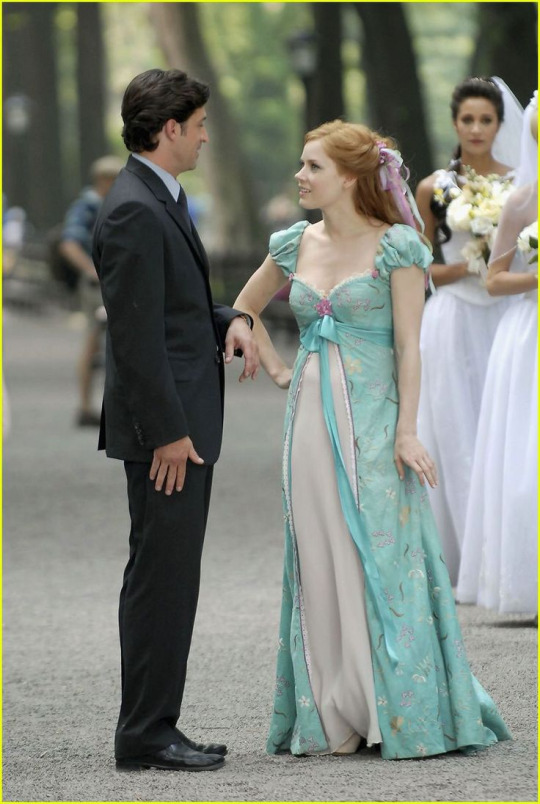
and this:
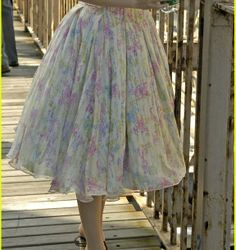
and here's the "made-over" look:
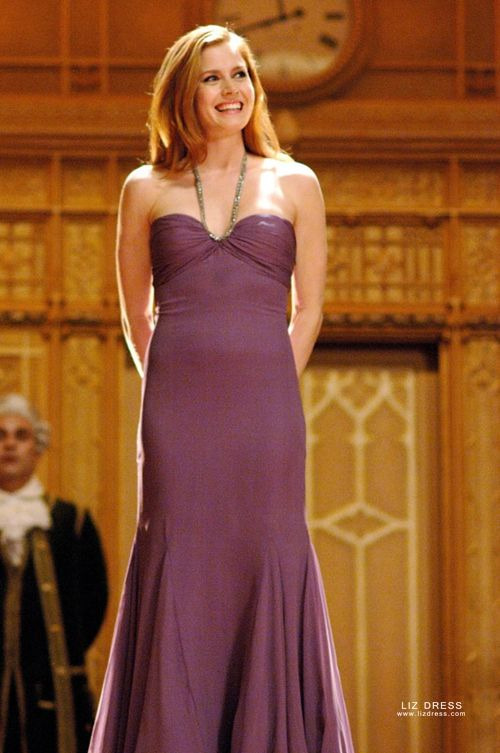
(god it doesn't even FIT THE ACTRESS FLATTERINGLY I hate this look so incredibly much she looks like a grape Flintstones ice cream pop)
now, I see why this commenter said the first looks were childish. one has a long flowy skirt for everyday attire, her hair has flowers and ribbons in it for both, the fabrics are pastel with a floral print- all things that are a far cry from the sleek, muted or neutral vision we have of adulthood nowadays
and I HATE that those things read as "childish" to me. I hate that I can see it. because they didn't always come across that way, and they shouldn't. there's nothing inherently juvenile about decorated, pretty clothing
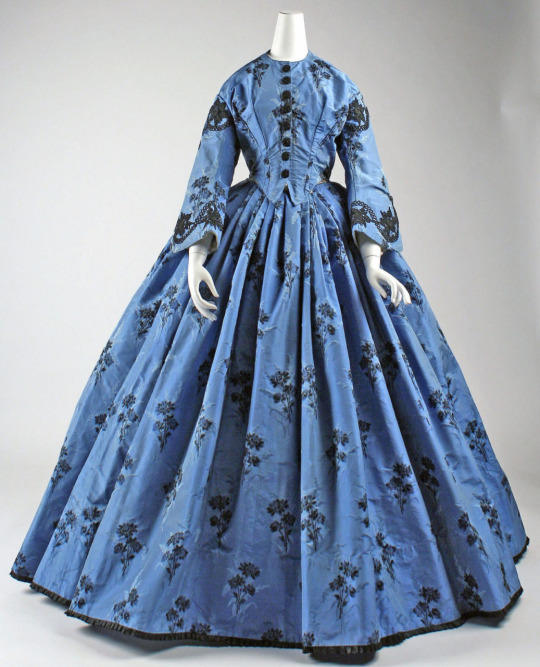
This is a dress for an adult woman c. 1863
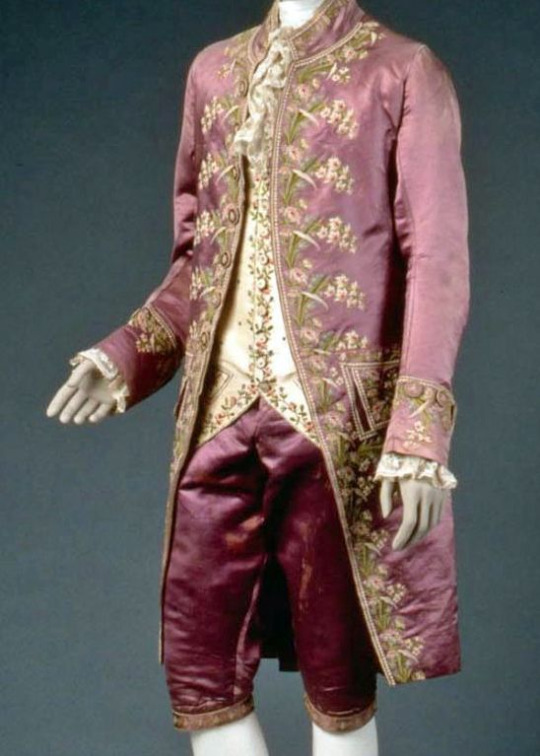
this is a (formal) suit for an adult man c. 1770
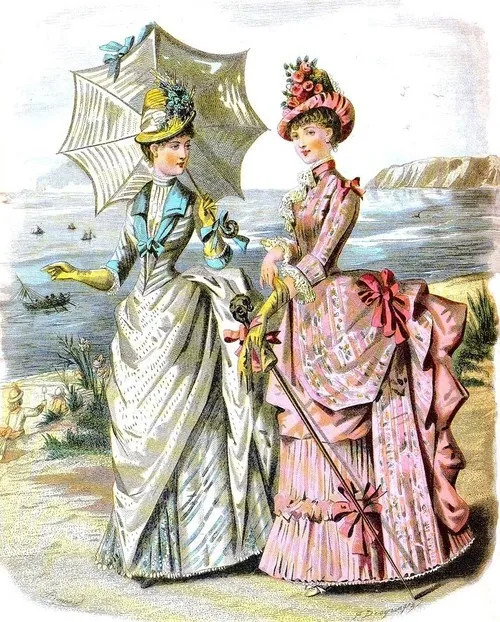
This is a fashion plate from 1886
and that's just western fashion from relatively recent history- cultures all over the world have loved decorating clothing, accessories, furniture, and spaces intended for mixed-age or entirely adult use
there's nothing innately childish about bright or pastel colors (or even jewel tones- Adult Clothing seems to comprise nothing but neutrals, these days). or flowers. or ribbons. or just...decorated clothing, at all. why do we see it that way? how much joy are we robbing ourselves of in a quest to be Perfectly Mature by an incredibly exacting standard that didn't even exist for most of human history?
#enchanted#fashion#adulthood#design#maybe that's why landlords remove decorative molding from old houses (a sin a mortal sin WHY)#they're trying to make something from a time when adults were allowed beauty#fit a time when we're supposed to be Above That
381 notes
·
View notes
Text
Fish and Chips’ Surprising Jewish History. Jamie Oliver confirmed it!
You may be surprised to learn that fish and chips, though wildly popular in England for what seems like eternity, was actually a specialty of the Portuguese Sephardic Jews who fled the Inquisition in the 16th century and found refuge in the British Isles. Celebrity Chef Jamie Oliver referred to this recently in an article in the New York Times, adding that, “Dishes evolve, impacted by trade, war, famine and a hundred other forces.”

Among those “other forces” are dishes born of religious ritual. For observant Jews, fish is pareve, a neutral food in kosher terms, thus an easy way to avoid treyf (non-kosher food) and possibly include dairy in the same meal. It was especially important for Marranos, the so-called crypto-Jews, who pretended to be Christian during the Inquisition. They ate fish on Fridays, when meat was forbidden by the Church, and also saved some to eat cold the next day at lunch, to avoid cooking on Shabbat.
Frying was natural for Jewish home cooks — think of latkes and sufganyiot — and as the Jewish community began to flourish in England, it spurred a taste for its beloved fried, battered fish throughout the country. According to Claudia Roden’s The Book of Jewish Food, Thomas Jefferson tried some on a trip to London and noted that he ate “fish in the Jewish fashion” during his visit. Alexis Soyer, a French cook who became a celebrated chef in Victorian England included a recipe for “Fried Fish, Jewish Fashion” in the first edition of his cookbook A Shilling Cookery for the People (1845). Soyer’s recipe notes that the “Jewish manner” includes using oil rather than meat fat (presumably lard), which made the dish taste better, though also made it more expensive.
There’s some dispute about the where and when of “chips” (what we Americans call French fries and the French call pommes frites). Many historians say that deep-fried, cut-up potatoes were invented in Belgium and, in fact, substituted for the fish during hard times. The first time the word “chips” was used was in Charles Dickens’ A Tale of Two Cities in 1859: “husky chips of potato, fried with some reluctant drops of oil.”
The official pairing of fish and chips didn’t happen until a few years later, though. Although there are some who dispute it, most authorities say that it is thanks to a Jewish cook, this time a young Ashkenazi immigrant named Joseph Malin, who opened the first British chippy, AKA fish and chip shop, in London in 1863. The shop was so successful it remained in business until the 1970s.
Who could foresee that fearful Jewish immigrants hiding their true religion and practicing in secret would be responsible for creating one of the most iconic dishes in the U.K.? The down-home dish that Winston Churchill claimed help the British defeat the Nazis, the comfort food that George Orwell said helped keep the masses happy and “averted revolution.” The dish, by the way, that was among the only foods never rationed during wartime because the British government believed that preserving access to it was a way of keeping up morale. A dish that continues to be a mainstay of the British diet.
Think about that the next time you find yourself feasting on this centuries-old — Jewish? British? — recipe.
These days, some restaurants are putting a new spin on fish and chips. Almond crusted. Baked instead of fried. Quinoa coated. Sweet potato fries instead of regular. And those are all fine; as Oliver says, “Dishes evolve.” But plain old fish and chips endures and probably always will. Good recipes usually do.
H/T : @scartale-an-undertale-au
Naveed Anjum
#Jews#crypto jews#jewish cuisine#fish and chips#israel#secular-jew#jewish#judaism#israeli#jerusalem#diaspora#secular jew#secularjew#islam#global cuisine#global foods#cooking#home cooking#history of food#fish n chips#marrano#jamie oliver#chippy#England#London#Britain
305 notes
·
View notes
Text

Mid-century was the era of shiny foil wallpaper and bright floral patterns. Here's a 1962 time capsule that has the hippest decor of the period. It's in Abington, PA, has 4bds, 2.2ba, and $449,900.

The entrance foyer is elegant in foil paper that looks like a mirrored wall.


The living room is open.

And, it's a large space.

The dining room has nice uplighting.


The kitchen is surprisingly large and is eat-in.

And, just like a modern open concept home, it shares space with the family room.

There's a nice modern fireplace and doors to the patio.

Check out the completely original blue guest powder room. They even have the custom made vertical blinds and they look brand new.

Very large back room has lots of space for freezers, a desk, whatever. It has the floral wallpaper with a matching shade and valance. It was also the fashion to wallpaper the ceilings.

Going up to the bedrooms. White wrought iron railings were popular.

The spacious primary bedroom.

Has a nice walk-in closet.

The yellow primary bath has a fancy original sink cabinet and a vanity table, plus the original yellow sink.

The secondary bedroom is large, too. It was also the fashion to wallpaper everything, like the closet doors and light switches.

This home is beautifully preserved. Original bath with an overhead light, shiny foil wallpaper, and double pink sinks.

This very large room is on the lower level.

Huge rec room has a picture window with a door to the yard.

Another guest powder with a corner sink.

Oh, it has a cedar closet for wool clothes so the moths don't get them.


A big basement with laundry and a workshop.

The garage is in the back of the house.

Patio.

There's lots of room for a pool on the .43 acre lot.

It's really a gem.
https://www.compass.com/listing/1863-hemlock-circle-abington-pa-19001/296867959288971521/
148 notes
·
View notes
Photo

La Mode illustrée, no. 7, 16 février 1863, Paris. Toilettes de Bal. Ville de Paris / Bibliothèque Forney
Description de toilettes:
Jupe en taffetas bleu, garnie avec deux volants doubles, tuyautés à très-gros plis, ayant (le premier volant) 12 et 10 centimètres de hauteur. Sur cette jupe, robe de tulle blanc, composée de quatre bouillonnés disposés en ondulations; le dernier bouillonné est terminé par une blonde blanche, ayant 8 centimètres de hauteur, surmontée d'un ruban de velours bleu, ayant 3 centimètres de largeur; chaque bouillonné est séparé du suivant par un même ruban (le velours. A chaque pointe des bouillonnés, sur le velours bleu, se trouve une rose rosée sans feuillage. Le corsage est en taffetas bleu, et fait en forme de corsage bernois, c'est-à-dire très-bas; il est surmonté d'une haute draperie en tulle blanc; une rose est posée sur la pointe supérieure, c'est-à-dire devant le corsage; les manches sont des bouillonnés en tulle blanc ornés d'une rose, bordés d'une bande de taffetas bleu, terminée par une dentelle blanche, et surmontés d'une épaulette tuyautée eu taffetas bleu. Coiffure de roses rosées et de rubans de velours bleu.
Robe en satin jaune doré. Le bas de la jupe est garni avec une dentelle noire, ayant 6 centimètres de largeur, disposée en treillage; une dentelle noire étroite est posée sur le côté uni (opposé au dessin). Corsage décolleté, garni d'une berthe reproduisant le treillage de la jupe; manches courtes, composées (l'un large bouillonné de satin, et d'un second bouillonné moins volumineux en tulle blanc. Coiffure de grenades rouges; collier et bracelet en corail rouge; large broche assortie, c'est-à-dire en corail rouge à pendeloques.
—
Skirt in blue taffeta, trimmed with two double ruffles, piped with very large pleats, having (the first ruffle) 12 and 10 centimeters in height. On this skirt, dress of white tulle, composed of four bubbles arranged in undulations; the last bubble is terminated by a white blonde, 8 centimeters high, surmounted by a blue velvet ribbon, 3 centimeters wide; each bouillonné is separated from the next by the same ribbon (the velvet. At each point of the bouillonné, on the blue velvet, is a dewy rose without foliage. The bodice is in blue taffeta, and made in the shape of a Bernese bodice, it is to say very low; it is surmounted by a high drapery in white tulle; a rose is placed on the upper point, that is to say in front of the bodice; the sleeves are swirls in white tulle adorned of a rose, edged with a band of blue taffeta, finished with white lace, and surmounted by a piped epaulette of blue taffeta. Headdress of pink roses and blue velvet ribbons.
Golden yellow satin dress. The bottom of the skirt is trimmed with black lace, 6 centimeters wide, arranged in a trellis; a narrow black lace is laid on the plain side (opposite to the design). Low-cut bodice, trimmed with a bead reproducing the trellis of the skirt; short sleeves, composed (one wide bubbled with satin, and a second less voluminous bubbled with white tulle. Hairstyle of red pomegranates; necklace and bracelet in red coral; large matching brooch, i.e. in coral red with pendants.
#La Mode illustrée#19th century#1800s#1860s#1863#periodical#fashion#fashion plate#color#retouch#description#Forney#dress#toilette#ensemble#ball#gown#taffeta#blue#yellow#satin#trellis#bubbles
217 notes
·
View notes
